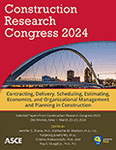Are We on the Same Wavelength? Exploring Inter-Brain Synchrony of Engineering Student Teams When Designing and Building
Publication: Construction Research Congress 2024
ABSTRACT
The collective performance of construction project teams results from individuals sharing ideas and actions, and this collaboration shapes their values toward common goals. Inter-brain synchrony (IBS) is a potential explanation for team performance, which is the coordinated brain activation across individuals. IBS is observed in other disciplines but not adequately studied in engineering and construction project teams. The purpose of the research presented in this paper was to explore the existence of IBS in engineering project teams during design and build activities. The study included 16 undergraduate fourth-year civil engineering students who were paired to form eight dyads. Each team was given the same three tasks varying in time and budget constraints. Team members wore a brain imaging device that measured the change in oxygenated blood in their prefrontal cortex. IBS was observed among all the teams but more prominent in some teams over others. Specific regions of the prefrontal cortex also expressed more IBS than others. The connection between IBS and team cooperation and performance varied. Further exploration is needed to better understand the role of IBS in team dynamics and performance.
Get full access to this article
View all available purchase options and get full access to this chapter.
REFERENCES
Babcock, L., and A. Vallesi. 2015. “The interaction of process and domain in prefrontal cortex during inductive reasoning”. Neuropsychologia. 67, 91–99. https://doi.org/10.1016/j.neuropsychologia.2014.12.010.
Balters, S., J. G. Miller, R. Li, G. Hawthorne, and A. L. Reiss. 2023. “Virtual (zoom) interactions alter conversational behavior and interbrain coherence.” The Journal of Neuroscience, 43 (14), 2568–2578. https://doi.org/10.1523/JNEUROSCI.1401-22.2023.
Blumenfeld, R. S., C. M. Parks, A. P. Yonelinas, and C. Ranganath. 2011. “Putting the pieces together: the role of dorsolateral prefrontal cortex in relational memory encoding.” Journal of Cognitive Neuroscience, 23 (1), 257–265. https://doi.org/10.1162/jocn.2010.21459.
Chang, C., and G. H. Glover. 2010. “Time-frequency dynamics of resting-state brain connectivity measured with fMRI.” NeuroImage, 50 (1), 81–98. https://doi.org/10.1016/j.neuroimage.2009.12.011.
Crivelli, D., and M. Balconi. 2017. “Near-infrared spectroscopy applied to complex systems and human hyperscanning networking.” Applied Sciences, 7 (9), Article 9. https://doi.org/10.3390/app7090922.
Cui, X., D. M. Bryant, and A. L. Reiss. 2012. “NIRS-based hyperscanning reveals increased interpersonal coherence in superior frontal cortex during cooperation.” NeuroImage, 59 (3), 2430–2437. https://doi.org/10.1016/j.neuroimage.2011.09.003.
Czeszumski, A., S. Eustergerling, A. Lang, D. Menrath, M. Gerstenberger, S. Schuberth, F. Schreiber, Z. Z. Rendon, and P. König. 2020. “Hyperscanning: A valid method to study neural inter-brain underpinnings of social interaction.” Frontiers in Human Neuroscience,14, 39. https://doi.org/10.3389/fnhum.2020.00039.
Fishburn, F. A., R. S. Ludlum, C. J. Vaidya, and A. V. Medvedev. 2019. “Temporal derivative distribution repair (TDDR): a motion correction method for fNIRS.” NeuroImage, 184, 171–179. https://doi.org/10.1016/j.neuroimage.2018.09.025.
Grinsted, A., J. C. Moore, and S. Jevrejeva. 2004. “Application of the cross wavelet transform and wavelet coherence to geophysical time series.” Nonlinear Processes in Geophysics, 11 (5/6), 561–566. https://doi.org/10.5194/npg-11-561-2004.
Hasson, U., and C. D. Frith. 2016. “Mirroring and beyond: Coupled dynamics as a generalized framework for modelling social interactions.” Philosophical Transactions of the Royal Society of London. Series B, Biological Sciences, 371 (1693), 20150366. https://doi.org/10.1098/rstb.2015.0366.
Herrera, R. F., C. Mourgues, L. F. Alarcón, and E. Pellicer. 2020. “Understanding interactions between design team members of construction projects using social network analysis.” Journal of Construction Engineering and Management, 146 (6), 04020053. https://doi.org/10.1061/(ASCE)CO.1943-7862.0001841.
Humphrey, S. E., and F. Aime. 2014. “Team microdynamics: Toward an organizing approach to teamwork.” Academy of Management Annals, 8 (1), 443–503. https://doi.org/10.5465/19416520.2014.904140.
Li, R., N. Mayseless, S. Balters, and A. L. Reiss. 2021. “Dynamic inter-brain synchrony in real-life inter-personal cooperation: A functional near-infrared spectroscopy hyperscanning study.” NeuroImage, 238, 118263. https://doi.org/10.1016/j.neuroimage.2021.118263.
Lu, K., H. Xue, T. Nozawa, and N. Hao. 2019. “Cooperation makes a group be more creative.” Cerebral Cortex, 29 (8), 3457–3470.
Mayseless, N., G. Hawthorne, and A. L. Reiss. 2019. “Real-life creative problem solving in teams: FNIRS based hyperscanning study.” NeuroImage, 203, 116161. https://doi.org/10.1016/j.neuroimage.2019.116161.
Molavi, B., and G. A. Dumont. 2012. “Wavelet-based motion artifact removal for functional near-infrared spectroscopy.” Physiological Measurement, 33 (2), 259. https://doi.org/10.1088/09673334/33/2/259.
Sato, T., et al. 2016. “Reduction of global interference of scalp-hemodynamics in functional near-infrared spectroscopy using short distance probes.” NeuroImage, 141, 120–132. https://doi.org/10.1016/j.neuroimage.2016.06.054.
Shin, J., J. Kwon, J. Choi, and C.-H. Im. 2017. “Performance enhancement of a brain-computer interface using high-density multi-distance NIRS.” Scientific Reports, 7 (1), 16545. https://doi.org/10.1038/s41598-017-16639-0.
Tak, S., and J. C. Ye. 2014. “Statistical analysis of fNIRS data: a comprehensive review.” NeuroImage, 85, 72–91. https://doi.org/10.1016/j.neuroimage.2013.06.016.
Tuckman, B. W., and M. A. C. Jensen. 1977. “Stages of small-group development revisited.” Group & Organization Studies, 2 (4), 419–427. https://doi.org/10.1177/105960117700200404.
Yu, J.-W., S.-H. Lim, B. Kim, E. Kim, K. Kim, S. Kyu Park, Y. Seok Byun, J. Sakong, and J.-W. Choi. 2020. “Prefrontal functional connectivity analysis of cognitive decline for early diagnosis of mild cognitive impairment: a functional near-infrared spectroscopy study.” Biomedical Optics Express, 11 (4), 1725. https://doi.org/10.1364/BOE.382197.
Information & Authors
Information
Published In
History
Published online: Mar 18, 2024
Authors
Metrics & Citations
Metrics
Citations
Download citation
If you have the appropriate software installed, you can download article citation data to the citation manager of your choice. Simply select your manager software from the list below and click Download.
